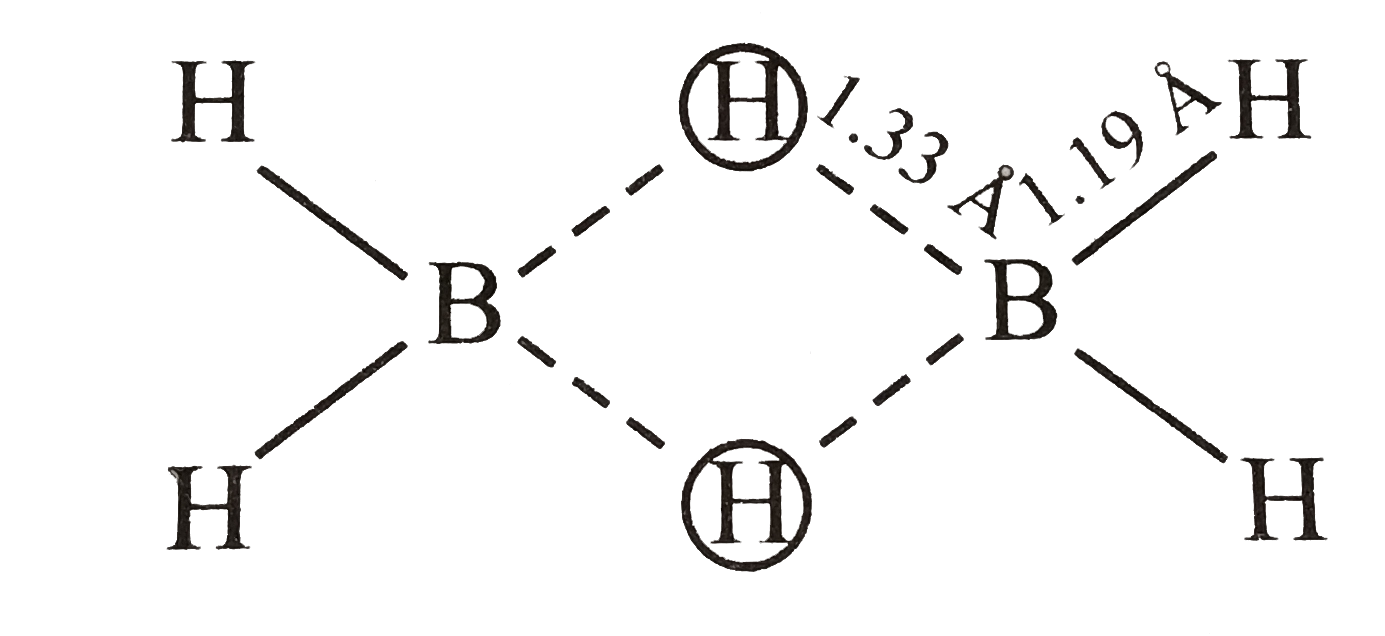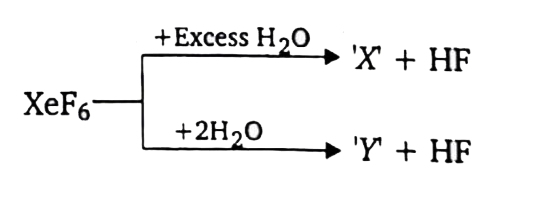Complete Solutions to LEVEL 2 of chapter p-BLOCK ELEMENTS of Class 12 book with complete answers and questions
| Class 12 | CHEMISTRY |
| Chapter | p-BLOCK ELEMENTS |
| VK JAISWAL | LEVEL 2 |
| Number Of Questions | 97 |
| Academic Year | 2023-24 |
`BX_(3)+NH_(3) overset(B.T.) to BX_(3) *NH_(3)`+Heat of adduct formation `(DeltaH)`
The numberical value of `DeltaH` is found to be maximum for:
View SolutionWhich is the following properties describes the diagonal relationship boron and silicon?
View SolutionAnhydrous `AlCl_(3)` is covalent however, when it is dissolved in water hydrated ionic species are formed. This transformation is owing to:
View SolutionBorax in its crystal posses:
View SolutionThe molecular shapes of diborane is shown below :
 .
.
Consider the following statements for diborane :
(i) Boron is approximately `sp^(3)` hybridised.
(ii) `B-H-B` angle is `180^@`
(iii) There are two terminal `B-H` bonds for each boron atom.
(iv) There are only `12` bonding electrons available of These statements :
View SolutionAlumiium vessels should not be washed with materials containing washing soda because:
View SolutionWhich of the following statements about anhydrous aluminium chloride is correct?
View Solution`Na_(2)B_(4)O_(7).10H_(2)Ooverset("Heat")rarrX + NaBO_(2) + H_(2)O, X + Cr_(2)O_(3) overset("Heat")rarrunderset(("Green coloured"))Y`
X and Y are :
View SolutionBorax is converted into amorphous Boron by following steps
`"Borax"overset(X)toH_(3)BO_(3)overset(triangle)toB_(2)O_(3)underset(triangle)overset(Y)toB`
X and Y are respectively
View SolutionThe dissolution of `Al(OH)_(3)` by a solution of `NaOH` results in the formation of
View SolutionChoose the correct sequence for the geometry of the given molecules
Borazon, Borazole,`B_(3)O_(6)^(3-)`, trimer of FCN.
['P' stands for planer and 'NP' standes for non-planer]
View SolutionWhat is not true about borax ?
View SolutionHow can the following reaction be made to proceed in forward direction ?
`B(OH)_(3) + NaOH hArr Na[B(OH)_(4)]`.
View SolutionWhich of the following catio can not give bead test?
View Solution
The incorrect statement regarding above reactions is:
View SolutionThe incorrect statement regarding 'X' in given reaction is:
`BF_(3)+LiAlH_(4) to overset("Ether")to(X)+LiF+AlF_(3)`
View SolutionThe incorrect stability order of +3 and +1 states of 13th group elements (boron family) is:
View SolutionConsider the following route of reaction:
`R_(2)SiCl_(2)+"water" to (A) overset("Polymerisation")to (B)`
Compound(B) in above reaction is:
View SolutionThe most basic oxide of elements group 14 of the periodic table is:
View Solution`(Si_(2)O_(5))_(n)^(2n-)` anion is obtained when:
View SolutionAmphilbole silicate structure has 'x' number of corner shared per tetrahedron. The value of x is :
View SolutionThe silicate ion in the mineral kinoite is a chain of three `SiO_(4)^(4-)` tetrahedral that share corners with adjacent tetrahedral. The mineral also contains `Ca^(2+)` ions, `Cu^(2+)` ions and water molecules in ` 1 : 1 : 1` ratio. The mineral is represented as
View SolutionChoose the correct order of C-C bond length in the given compounds:
View SolutionSilicate having one monovalent corner oxygen atom in each tetrahedron unit is
View SolutionIn which of the following silicates, only two corners per tetrahedron are shared ?
I. Pyrosilicate
II. Cyclic silicate
III Double chain silicate
IV Single chain silicate
V 3D Silicate
View SolutionThe correct code for stability, of oxidation states for given cations is:
(i) `Pb^(2+) gt Pb^(4+) ,Tl^(+) lt Tl^(3+)`
(ii) `Bi^(3+) lt Sb^(3+) , Sn^(3+) lt Sn^(4+)`
(iii) `Pb^(3+) gt Pb^(4+),Bi^(3+) gt Bi^(3+)`
(iv) `Tl^(3+) lt ln^(3+), Sn^(2+) gt Sn^(4+)`
(v) `Sn^(2+) lt Pb^(2+) , Sn^(4+) gt Pb^(4+)`
(vi) `Sn^(2+) lt Pb^(2+), Sn^(4+) lt Pb^(4+)`
View SolutionNitrogen gas is liberated by thermal decomposition of:
View SolutionTwo oxides of Nitrogen, NO and `NO_(2)` reacts together at 253 K and form a compound Nitrogen X.X reacts with water to yield another compound of Nitrogen Y. The shape of the anion of Y molecule is
View SolutionConsider the following sequence of reaction:
`Na+NH_(3)(g) to [X]overset(N_(2)O)to[Y] overset(Heat)tounderset("Gas pure")([Z])`
Identify [Z] gas:
View SolutionWhich of the following oxyacid contains both P-H and P-P bond simultaneously?
View SolutionAmong the following statement which one is true?
View SolutionWhich of the following statements regarding `N_(2)O_(4)` is/are correct?
View SolutionWhich of the following on heating produces `NO_(2) ` ?
View SolutionWhich of the following equation is incorrectly written?
View SolutionThe cyclotrimetaphosphoric acid is:
View Solution`A+H_(2)O to B+HCl`
`B+H_(2)O to C+HCl`
Compound (A), (B) and (C) will be respectively:
View SolutionIt is recommended that ammonia bottles be opened after cooling in ice for sometime. This is because
View SolutionWhich of the following statements are correct about the reaction between the copper metal and dilute `HNO_(3)`?
View SolutionIn which of the following acids, P-P bonds is present?
View Solution`NH_(3)+O_(2) underset(Delta)overset(Pt) to A+H_(2)O`
`A+O_(2) to B`,
`B+O_(2)+H_(2)OtoC`
A, B and C are:
View SolutionThe formation of `PH_(4)^(+)` is diffficult compaired to `NH_(4)^(+)` because:
View SolutionNitrozen (i) oxide is produced by
View SolutionAmongst the following compounds
(I) `H_(5)P_(3)O_(10)`
(II) `H_(6)P_(4)O_(13)`
(III) `H_(5)P_(5)O_(15)`
(IV) `H_(7)P_(5)O_(16)`
non-cyclic phosphates are:
View SolutionMatch List-I with List-II and select the correct answer using the codes given below the lists:

View SolutionWhich is the correct sequence in the following properties. For the correct order mark `( T)` and for the incorrect order mark `( F) :`
`{:((a)"Acidity order ":SiF_(4) lt SiCl_(4) lt SiBr_(4) lt Sil,,
(b)"Melting point":NH_(3) gt SbH_(3) gt AsH_(3) gt PH_(3),,),
((c )"Boiling point " :NH_(3) gt SbH_(3) gt AsH_(3) gt PH_(3),
,(d)"Dipole moment order ":NH_(3) gt SbH_(3) gt AsH_(3) gt PH_(3),=,5):}`
View SolutionAn orange solid (X) on heating, gives a colourless gas (Y) and a only green residue (Z). Gas (Y) on treatment with Mg, produces a white solid substance……
View SolutionCalcium imide on hydrolysis will give gas `(B)` which on oxidation by beaching powder gives gas `(C)` gas `(C)` on reaction with magnesium give compound `(D)`. `(D)` on hydrolysis gives gas `(B)`. `(B), (C)` and `(D)` are
View SolutionAmong the following compounds, which on heating do not produce `N_(2)` ?
View SolutionIn which of the following compounds hydrolysis tkes plcae through `S_(N^(1)) and S_(N^(2))` mechanism respectively?
View SolutionIncorrect statement about `PH_(3)` is:
View SolutionWhich of the following compound does not give oxyacid of central atom on hydrolysis?
View SolutionThe incorrect statement regarding 15th group hyrides `(EH_(3)).[E=N,P,As,Sb,Bi]`
View SolutionCalculate x+y+z for `H_(3)PO_(3)` acid, where x is number of lone pairs, y is number of `sigma`-bonds and z is number of `pi`-bonds
View SolutionA non-metal M forms `MCl_(3),M_(2)O_(5) and Mg_(3)M_(2)` but does not form `MI_(5)`, then incorrect statement regarding non-metal M is
View SolutionThe incorrect order is:
View SolutionThe correct order of S-S bond length in following oxyanions is:
`S_(2)O_(4)^(2-)`
(II) `S_(2)O_(5)^(2-)`
(III) `S_(2)O_(6)^(2-)`
View SolutionIn which of the following reaction product does not contian 'peroxoy' linakge?
View SolutionConsider the following statements in respect of oxides of sulphur:
(1) in gas phase `SO_(2)` molecule is V_shape.
(2) In gas phase `SO_(3)` molecule is planar.
(3) `gamma-SO_(3)` is cyclic trimer.
Which of the above statements are correct?
View SolutionGas that can not be collected over water is:
View SolutionIn thiosulphuric acid:
View SolutionOne gas bleaches the colour of flowers by reduction, while the other by oxidation, the two gases respectively are:
View SolutionWhich of the following halides cannot be hydrolysed at room temperature?
(I) `TeF_(6)`
(II) `SF_(6)`
(III) `NCl_(3)`
(IV) `NF_(3)`
Choose the correct code:
View SolutionBy which of the following methods, `H_(2)O_(2)` can't be synthesised?
View SolutionGive the correct order of initials T or F for following statements. Use T if statements is true and F if if false.
`(I)` Number of `S-S` bond in `H_(2)S_(n)O_(6)` are `(n+1)`
`(II)` When `F_(2)` reacts with water gives `HF,O_(2)` and `O_(3)`
`(III)` `LiNO_(3)` and `BaCl_(2)` compounds are used in the fire works
`(IV)` Be and Mg hydrides are ionic and polymeric
View SolutionWhich of the following parent acid(s) does/do not have corresponding hypo-oxyacid?
View SolutionWhich pair of elements cann from multiple bond with itselff and oxygen?
View SolutionConsider the following reactions:
(i) `PCl_(3)+3H_(2)O to H_(3)PO_(3) +3HCl`
(ii) `SF_(4)+3H_(2)O to H_(3)SO_(3)+4HF`
(iii) `BCl_(3)+3H_(2)O to H_(3)BO_(3)+3HCl`
(iv) `XeF_(6)+3H_(2)O to XeO_(3)+6HF`
Then according to given information the incorrect statement is:
View SolutionConsider the oxy acids `HClO_n` series here value of n is 1 to 4. then incorrect statement regarding these oxyacids Is:
View SolutionThe correct statement regarding `ClO_(n)^(-)` molecular ion is:
View SolutionIn, `Cl_(2)O_(6)(l)+HF to P+Q`
If `H^(-)` of acid HF attraches with Q, then correct option of hybridization of Cl-atom and `angle OClO` in the P and Q ions:
View SolutionBromine is commercially prepared from sea water by displacement reaction
`Cl_(2)+2Br^(-)(aq) to 2Cl^(-)(aq)+Br_(2)`
`Br_(2)` gas thus formed is dissolved into solution of `Na_(2)CO_(3)` and then pure `Br_(2)` is obtained by treatment of the solution with:
View SolutionWhich of the following properties of halogens increase with increasing atomic number?
(I) Ionization energy
(II) Ionic radius
(III) Bond energy of the `X_(2)` molecule
(IV) Enthalpy of vaporisation
View SolutionPredict the correct product when `Cl_(2)` passed through `H-overset(18)(O)-overset(18)(O)-H` solution.
View Solution`Cl_(2)(g)+Ba(OH)_(2) to X(aq.)+BaCl_(2)+H_(2)O`
`X+H_(2)SO_(4) to Y+BaSO_(4)`
`Y underset(Deltagt365K)overset(Delta) Z+H_(2)O+O_(2)`
Y and Z are respectively:
View SolutionAuto-oxidation of bleaching powder gives:
View SolutionWhich is incorrectly matched?
View SolutionThe three elements X,Y and Z with electronic configuration shown below al form hydrides:
`{:("Element","Electronic configuration"),(X,1s^(2)2s^(2)2p^(2)),(Y,1s^(2)2s^(2)2p^(6)3s^(1)),(Z,1s^(2)2s^(2)2p^(6)3s^(2)3p^(6)3d^(10)4s^(2)4p^(5)):}`
Which set of properties match correctly with properties of the hydrides of these elements:
View SolutionThe incorrect order is:
View SolutionThe correct statement regarding perxenate ion `(XeO_(6)^(4-))` is:
View Solution`XeF_(2)` and `XeF_(6)` are separately hydrolysed then:
View Solution`Mf + XeF_(4) rarr M^(+) A^(-) (M^(+)-` alkali metal cation) The state of hybridisation of the central atom in A and sphere of the species are:
View SolutionXenon tetrafluoride, `XeF_(4)` is:
View Solution`XeF_(6)` dissolves in anhydrous HF to give a good conducting solution which contains:
View SolutionWhich of the following is not true about helium ?
View Solution`SbF_(5)` reacts with `XeF_(4)` to form an adduct. The shapes of cation and anion in the adduct are respectively:
View SolutionConsider the followingg transformations:
(I) `XeF_(6)+NaF to Na^(+)[XeF_(7)]^(-)`
(II) `2PCl_(5)(s) to [PCl_(4)]^(+)[PCl_(6)]^(-)`
(III) `[Al(H_(2)O)_(6)]^(3+)+H_(2)O to [Al(H_(2)O)_(5)OH]^(2+)+H_(3)O^(+)`
Possible transformations are:
View SolutionWhich of the following is an uncommon hydrolysis product of `XeF_(2) and XeF_(4)`?
View SolutionIncorrect statement regarding following reaction is:

View SolutionWhich of the following noble gases does not form clatherates?
View SolutionCorrect order of bond angle in given species is:
View SolutionThe incorrect order is:
View SolutionAmong the following, cyclic species are:
(I) `H_(5)P_(3)O_(10)`
(II) `[B_(3)O_(3)(OH)_(5)]^(2-)`
(III) `H_(5)P_(5)O_(15)`
(IV) `P_(3)N_(3)Cl_(6)`
View SolutionThe substance that has the lowest boililng point is:
View SolutionWhich of the following molecule can show Lewis acidity?
(I) `CO_(2)`
(II) `Br_(2)`
(III) `SnCl_(2)`
(IV) `HF`
View SolutionMolecule having non-pola as well as polar bonds but the molecule as a whole is polar:
View SolutionWhich of the following order is incorrect?
View SolutionWhich of the following does not under Lewis acid-basic reaction?
View Solution
LEVEL 2 questions and complete solutions for chapter p-BLOCK ELEMENTS of VK JAISWAL CHEMISTRY (HINGLISH) of Class 12